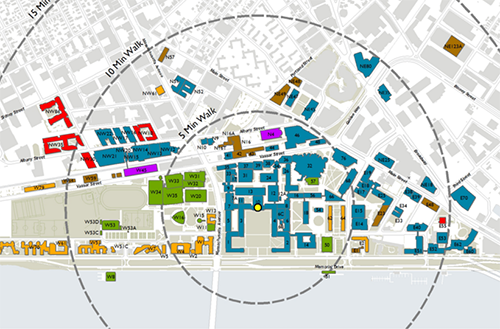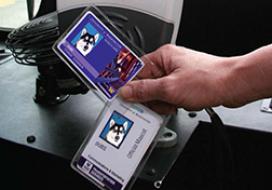What Transportation Planners Can Learn About Ridesharing from College Campuses
College campuses have long had alternative transportation options. But these options, such as fixed bus routes or carpooling, have never provided enough transportation coverage to greatly reduce the number of students, faculty, and staff who drive alone in a personal vehicle.
Now, new ridesharing technologies and transportation demand management (TDM) strategies mean that how people travel to and from campus may be changing and nearing a tipping point where these strategies work in combination to provide a more attractive package than driving alone.
“We’re seeing smartphone-based casual carpooling, commuter clubs, transit passes integrated into ID cards, bike sharing, and much more,” said Volpe community planner Kevin McCoy during a recent webinar hosted by the Federal Highway Administration (FHWA) and Volpe on ridesharing on college campuses. “The landscape is changing very quickly with new technologies and business models popping up all the time.”
Universities are Real-World Ridesharing and TDM Laboratories
To address transportation demand, universities have long experimented with alternatives to single-occupant cars. Free or discounted public transit passes, subsidized parking for carpoolers, and bike sharing are some of the options universities provide to their students and employees.
“Universities are real-world laboratories,” said William Lyons, principal technical advisor for transportation planning at Volpe. Lyons is co-author with McCoy and James Andrew of a recent report that offers lessons and case studies on campus ridesharing technology that can be used by state, regional, and local transportation agencies.
The report is the fourth in a series of five Federal Highway Administration reports by Volpe on ridesharing and transportation demand management.
“We’re approaching campus programs as valuable laboratories for insights for communities in general, and particularly for metropolitan planning organizations,” Lyons said.
Campus Case Studies
Several universities have fostered partnerships with private companies to address the demands campuses place on transportation. Yale University and the Massachusetts Institute of Technology (MIT) collaborate with ZipCar to provide students discounted and easy-to-access rides.
MIT has also developed a real-time trip planning tool, AccessMyDashboard, that lets staff compare various modes of transportation by time, cost, and sustainability. To encourage alternatives to single-driver cars, commuters are awarded points for choosing the most sustainable option.
“The goal of the commuter program is to reduce parking permits by 75 percent and shift car use from daily to occasional,” said Larry Brutti, operations manager for parking and transportation at MIT.
By shifting to daily rate parking, drivers avoid a “sunk cost” problem, where they need to pay to park in advance of a semester or monthly basis, Brutti said. On days when MIT students or staff don’t need to drive, they can shift to public transportation, provided to them at no cost by MIT, instead of paying for parking.
Universities are also developing policies and procedures to support these new ridesharing technologies and TDM strategies. They typically emphasize branding and outreach strategies to encourage usage, partnering with transportation agencies to identify cost-effective solutions, and forming close ties with local government to bring ridesharing technologies not just to campuses, but to communities.

Applying TDM at the Regional Level
The webinar featured a panel of ridesharing planners and practitioners who discussed the potential to apply strategies from the university case studies to a regional planning scale.
“How do we engage people to do things differently?” said Paul Minett, managing director of the Ridesharing Institute. “Particularly in the sense of maintaining the gains, not having induced traffic or latent demand just fill up [parking] spaces, so we incur a bunch of cost and effort to no net gain. How to get a community view of the entire road system is a huge challenge to work out.”
There are a few important differences in how campuses and larger municipalities operate. Regional transportation planning involves collaboration on transportation decisions at state, regional, and local levels. Different agencies are often responsible for different aspects of planning, such as transportation, land use, and operations.
“Regions can have growth in the right areas with the right strategies,” said Barbara Laurenson, of the Metropolitan Transportation Commission in the San Francisco Bay Area, during the FHWA/Volpe webinar. “Start small and focus on a corridor or promising area.”
University campuses are useful laboratories for how balanced approaches combining ridesharing and TDM can dramatically reduce single-occupant car trips, traffic congestion, and the demand for costly parking. Although regional planning agencies lack similar direct responsibility for parking, land use, and transportation, the positive results of the universities can encourage regions and communities to consider how they might collaborate with public- and private-sector partners to provide similar attractive transportation alternatives and accomplish similar results.
“We are seeing a change from traditional public-sector approaches to new partnerships with private industry and entrepreneurs providing tools to address transportation planning needs,” said Lorrie Lau, manager of the FHWA ridesharing and TDM research series. “We in the public sector need to collectively examine how we can adapt our roles in transportation planning.”

The University of Washington’s student ID card, the Husky Card, is integrated with the U-Pass program, which provides benefits, subsidies, and programs designed to incentivize people to choose options other than driving alone. (University of Washington photo)
